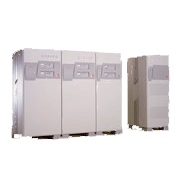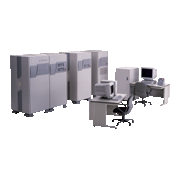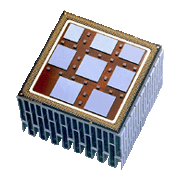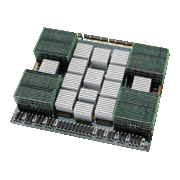The GS8000 series was Fujitsu’s new mainframe computer series running on standard CMOS*1 processors. Fujitsu announced two model groups (GS8400 and GS8200) in May 1995 as successors to the M-1000 series. Fujitsu added the high-end GS8600 model group in January 1996. The GS8600 models used a CMOS processor with 1.7 times the performance of those on the GS8400 models. The GS8000 series servers were intended to be core servers that backed mission-critical client-server applications and presided over corporate-wide information management and processing. For this reason, Fujitsu marketed the models as global servers (GS).
Features of the GS8000 series:
- (1)Fujitsu used CMOS technology (0.35 micron process) instead of ECL*2 for the first time in its large mainframes.
- (2)High mounting densities with MCM*3
- MCMs achieved higher mounting densities, which delivered better performance from the CMOS components.
- (3)Greater scalability with paralleling SCMP*4 technology
- The GS8400 group covered a 64-fold performance range, from the entry-level model (GS8400/10Q) to the eight-node cluster model (GS8400/800).
- (4)Online servicing/expansion*5 on cluster models gave the reliability needed for core business systems.
- *1. CMOS: Complementary metal oxide semiconductor.
- *2. ECL: Emitter coupled logic.
- *3. MCM: Multichip module. A module that mounts multiple LSI chips on a single substrate.
- *4. SCMP: SSU-Coupled Multiprocessors. SSU: System storage unit. A parallel-processing methodology first provided with the M-1800 model group (1990).
- *5. Online servicing/expansion: Ability to service (replace, etc.) or add components without stopping the computer. This technology is essential for 24-hour continuous computer operation.
| Model name | 10 | 20 | 30 | 40 | 60 | 80 |
|---|---|---|---|---|---|---|
| Introduced | January 1996 | |||||
| Relative performance* | 1 | 1.8 | 2.5 | 3.2 | 4.6 | 5.8 |
| No. of CPUs | 1 | 2 | 3 | 4 | 6 | 8 |
| Main memory capacity | 128MB - 4GB | 256MB - 8GB | ||||
| System memory capacity | 256MB - 16GB | |||||
| Channels | 16 - 248 | |||||
*Taking the performance of the GS8600/10 as the baseline.
| Model name | 200 | 300 | 400 | 500 | 600 | 700 | 800 |
|---|---|---|---|---|---|---|---|
| Introduced | January 1996 | ||||||
| No. of clusters | 2 | 3 | 4 | 5 | 6 | 7 | 8 |
| No. of CPUs | 1 to 8/cluster | ||||||
| System memory capacity | 256MB - 16GB (redundancy standard) | ||||||
| Cluster connection units | 2 (redundancy standard) | ||||||
| Model name | 10Q | 10R | 10S | 10 | 20S | 20 | 30 | 40 |
|---|---|---|---|---|---|---|---|---|
| Introduced | May 1995 | |||||||
| Relative performance* | 1 | 1.4 | 2.0 | 2.7 | 3.4 | 4.6 | 6.3 | 8.0 |
| No. of CPUs | 1 | 2 | 3 | 4 | ||||
| Main memory capacity | 512 MB max. | 1 GB max. | ||||||
| System memory capacity | 2 GB max. | |||||||
| Channels | 32 max. | 64 max. | ||||||
*Taking the performance of the GS8400/10Q as the baseline.
| Model name | 200 | 300 | 400 | 500 | 600 | 700 | 800 |
|---|---|---|---|---|---|---|---|
| Introduced | May 1995 | ||||||
| No. of clusters | 2 | 3 | 4 | 5 | 6 | 7 | 8 |
| No. of CPUs | 1 to 4/cluster | ||||||
| System memory capacity | 2 GB max. | 4 GB max. | |||||
| Cluster connection units | 1 | ||||||
| Model name | 10R | 10S | 10 | 20S | 20 | 30 | 40 |
|---|---|---|---|---|---|---|---|
| Introduced | May 1995 | ||||||
| Relative performance* | 1.0 | 1.3 | 1.7 | 2.3 | 3.0 | 4.2 | 5.0 |
| No. of CPUs | 1 | 2 | 3 | 4 | |||
| Main memory capacity | 252 MB max. | 380 MB max. | |||||
| System memory capacity | 128 MB max. | ||||||
| Channels | 32 max. | ||||||
*Taking the performance of the GS8200/10R as the baseline.
| Model name | 200 | 300 | 400 |
|---|---|---|---|
| Introduced | May 1995 | ||
| No. of clusters | 2 | 3 | 4 |
| No. of CPUs | 1 to 4/cluster | ||
| Cluster connection units | 1 | 2 | |
The specifications above were correct at the time the products were announced. Some specifications were later revised due to product upgrades.





